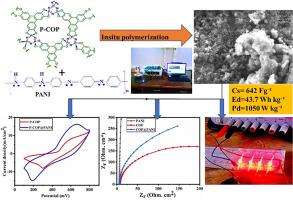In situ polymerization of aniline on phosphazene-based covalent organic polymer (P-COP) electrode material for enhanced supercapacitor energy storage
IF 5.6
3区 材料科学
Q1 ELECTROCHEMISTRY
引用次数: 0
Abstract
Supercapacitors offer long cycle life and high-power density for various applications. Phosphazene-based Covalent Organic Polymer (P-COP) is a popular electrode material due to its large surface area and pore structure. However, low conductivity and energy storage are practical constraints. To solve this problem, conducting polymer polyaniline (PANI) was incorporated via in-situ polymerization. The structure and characteristics of P-COP@PANI are described using SEM, TEM, XRD, TGA, XPS, BET, and electrochemical characterization methods like CV, GCD, and EIS. The specific capacitance of P-COP@PANI is 642 Fg⁻¹, which exhibited a maximum energy density of 43.7 Wh kg⁻¹ with a power density of 1050 W kg⁻¹ at a current density of 3 A g⁻¹ with the potential window 0 to 0.8 V. After 3000 cycles, it still kept 93.52 % of its capacity retention. The study emphasizes the necessity of incorporating P-COP into PANI to give high-performance supercapacitors, displaying better electrochemical qualities and creating the way for rational conceptualization of the future of energy storage materials.


苯胺在磷基共价有机聚合物(P-COP)电极材料上的原位聚合用于增强超级电容器储能
超级电容器为各种应用提供长循环寿命和高功率密度。磷腈基共价有机聚合物(P-COP)因其具有较大的比表面积和孔隙结构而成为一种流行的电极材料。然而,低电导率和能量存储是实际的限制。为了解决这一问题,采用原位聚合法制备了导电聚合物聚苯胺(PANI)。利用SEM、TEM、XRD、TGA、XPS、BET以及CV、GCD、EIS等电化学表征方法对P-COP@PANI的结构和特性进行了表征。P-COP@PANI的比容为642 Fg -⁻¹,其最大能量密度为43.7 Wh - kg -⁻¹,在3 a - g的电流密度下,其功率密度为1050 W - kg -⁻¹,电位窗口为0到0.8 V。经过3000次循环后,其容量保持率仍为93.52%。该研究强调了将P-COP纳入聚苯胺的必要性,以获得高性能超级电容器,展示更好的电化学质量,并为未来储能材料的合理概念化创造道路。
本文章由计算机程序翻译,如有差异,请以英文原文为准。
求助全文
约1分钟内获得全文
求助全文
来源期刊

Electrochimica Acta
工程技术-电化学
CiteScore
11.30
自引率
6.10%
发文量
1634
审稿时长
41 days
期刊介绍:
Electrochimica Acta is an international journal. It is intended for the publication of both original work and reviews in the field of electrochemistry. Electrochemistry should be interpreted to mean any of the research fields covered by the Divisions of the International Society of Electrochemistry listed below, as well as emerging scientific domains covered by ISE New Topics Committee.
 求助内容:
求助内容: 应助结果提醒方式:
应助结果提醒方式:


